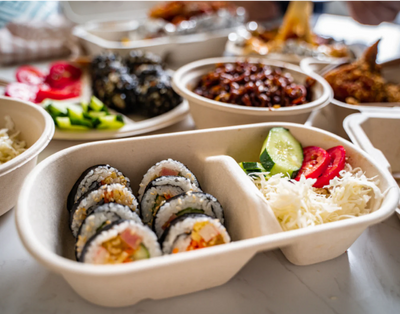When evaluating your experience of a good flight, what aspects do you consider? In my opinion, it must be the timing, the service, and, especially on a long flight, the meals they serve during the journey. Some may say, “Well, it’s just a short meal. Don’t overcomplicate it,” but to me, eating on the move is a whole different experience where many things can go wrong. And considering that the aviation industry is one of the fastest-growing in the world, it’s time for airlines to elevate their dining service to the next level.
With sustainability becoming a global trend, it would be a step backward for any airline that hasn't yet hopped on the bandwagon and shifted its services toward a more eco-conscious approach. So, let’s dive deeper into why and how airlines around the world can keep up with the pace and fly their way to the top.
Why Airlines Should Use Sustainable Packaging for Their Meals
As one of the industry leaders, aviation has long relied on single-use plastic products, generating approximately 6.1 million tons of plastic waste annually, accounting for 2% of the world’s plastic waste. A small shift in plastic use within this sector can make a significant impact overall.
Airplane meals are one of the areas where single-use plastic items, such as straws, cups, utensils, and food containers, are used the most. In the early days of airline meals, flimsy trays and foil-wrapped dinners were the norm. Compared to other modes of transportation, flying is by far the most expensive, and when people choose to spend their money on it, they expect a certain standard of service.
Not only are single-use plastic items harmful to the environment, but they also cheapen the overall experience that an airline provides, ultimately reducing customer satisfaction.
Therefore, shifting to more sustainable materials to replace these disposable products is a wise and straightforward move to navigate your airline toward success, winning both customers’ hearts and the planet’s.
Sustainable Alternative Products for Airline Meals
Thanks to technological advancements, more and more sustainable products are being developed to replace plastic, for good. These alternatives are often plant-based, plastic-free, and capable of decomposing naturally or in industrial composting facilities within just a few months.
Sugarcane Food Containers
These food containers are made from sugarcane bagasse, often considered a paper-like material without the need for cutting down trees. Thanks to the natural properties of sugarcane fibers, they are breathable, durable, and flexible, capable of holding liquid food for up to two hours. They can even be used in the microwave. The best part? They work just as well as plastic, and EQUO’s sugarcane food containers can completely break down in nature within six months.
Sugarcane Utensils
Sugarcane forks, spoons, and knives are the perfect alternatives to plastic utensils. Made from sugarcane fibers, they are durable and grease-resistant. More conveniently, they can compost in any environment within less than a year.
Compostable Plant-Based Straws
Forget about plastic straws, how could we ever go back to that era when we know they are choking marine animals, polluting beautiful landscapes, and even leaving behind waste that will outlive us for centuries?
These compostable straws, made from plant-based materials like rice, grass, coconut, coffee, and sugarcane, are a game changer for the drinking experience on airplanes. Available in a variety of materials, sizes, and even colors, they prove that small details can uplift the entire experience. And instead of staying on Earth for centuries, these straws take just 18 months to completely break down into organic matter, returning nutrients to the soil.
Fly High and Bright with Sustainable Products
Choosing an airline to travel with is not difficult these days, but making your airline stand out in customers' minds is a challenge. However, the answer is clear: top-notch service. From the staff and facilities to the products used on board, every detail speaks volumes about how much an airline cares about its customers and the environment we all share.
So next time, remember: the less plastic on your plane, the more satisfaction on your customers’ faces. And yes, the shortcut to love is through the stomach. Treat your passengers to a meal that feels like a five-star experience, and your plane will be packed with loyal customers.


